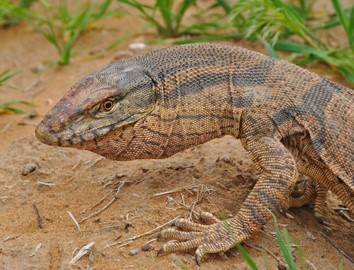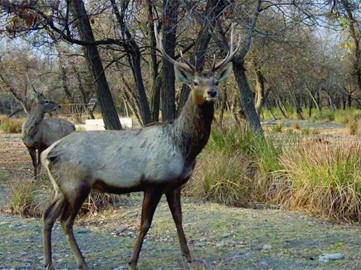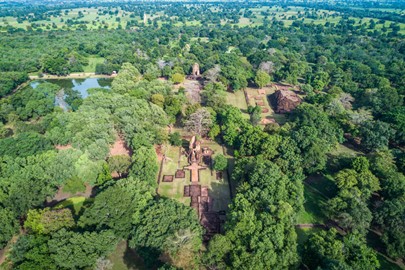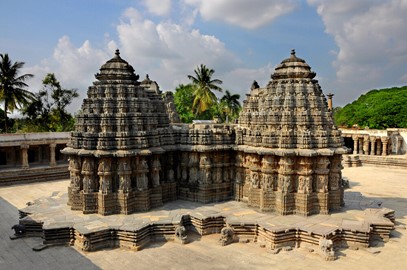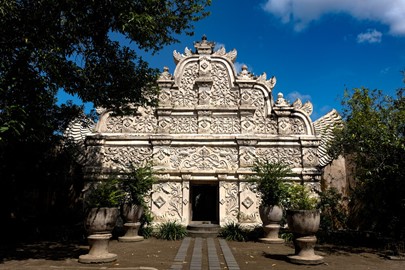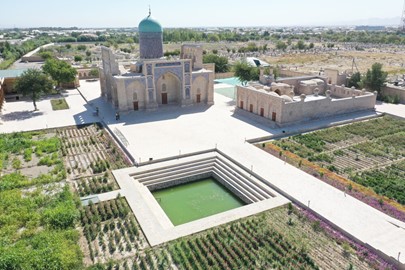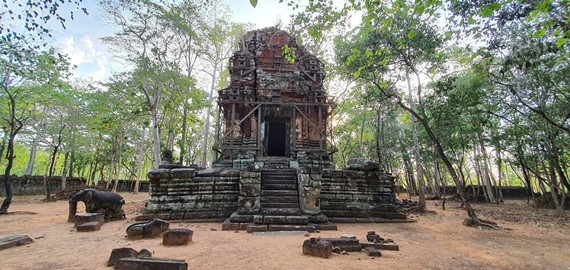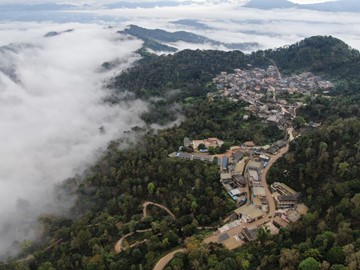region :: asia and the pacific
Cambodian Memorial Sites
The Cambodian Memorial Sites, inscribed on UNESCO's World Heritage List in 2025, encompass the M-13 Prison, Tuol Sleng Genocide Museum, and Choeung Ek Genocidal Centre, which serve as poignant reminders of the Khmer Rouge regime's atrocities from 1975 to 1979. These sites, once centers of repression, have transformed into places of peace, reflection, and education, preserving the memory of the victims of genocide. They symbolize Cambodia’s journey toward national reconciliation, justice, and healing, offeri... Read More
Murujuga
The Murujuga Cultural Landscape, inscribed on UNESCO’s World Heritage List in July 2025, is a globally significant site in Western Australia, renowned for its vast collection of over one million ancient Aboriginal petroglyphs, some dating back 50,000 years. Managed by the Murujuga Aboriginal Corporation, representing the Ngarda-Ngarli peoples, this living cultural landscape showcases a continuous record of human creativity, cultural traditions, and environmental interaction. The site’s inscription recognize... Read More
Xixia Imperial Tombs
The Xixia Imperial Tombs, inscribed on UNESCO’s World Heritage List in July 2025, are a significant archaeological site in China, preserving the legacy of the Tangut-led Western Xia Dynasty (1038–1227). Featuring nine imperial mausoleums and over 200 accompanying tombs, the site showcases unique pyramid-shaped structures and intricate burial artifacts, reflecting the dynasty’s distinct cultural and architectural achievements. Located at the foot of the Helan Mountains, these tombs provide valuable insights ... Read More
Maratha Military Landscapes
The Maratha Military Landscapes, inscribed on UNESCO’s World Heritage List in July 2025, encompass twelve forts across Maharashtra and Tamil Nadu, showcasing the Maratha Empire’s strategic military vision and architectural ingenuity from the 17th to 19th centuries. Developed under Chhatrapati Shivaji Maharaj and continued through Peshwa rule until 1818, these forts, including Raigad, Shivneri, and Gingee, reflect sophisticated defense systems and diverse fortification types, such as hill, coastal, and islan... Read More
Khorramabad Valley
The Prehistoric Sites of the Khorramabad Valley, inscribed on UNESCO’s World Heritage List in July 2025, are a significant archaeological treasure in Iran’s Zagros Mountains, featuring five caves and one rock shelter with evidence of human habitation dating back 63,000 years. Including the Kaldar, Yafteh, Konji, Gilvaran, Ghamari caves, and Gar Arjeneh rock shelter, these sites reveal traces of Neanderthal and early modern human activity, showcasing the valley’s role as a cradle of early human settlement. T... Read More
Forest Park Selangor
The Forest Research Institute Malaysia Forest Park Selangor (FRIM FPS), inscribed as a UNESCO World Heritage Site in July 2025, is a pioneering example of large-scale tropical forest restoration, transforming a former tin mining site into a thriving rainforest ecosystem since the 1920s. Located near Kuala Lumpur, this park features thousands of documented tree species, diverse wildlife, and attractions like the forest canopy walkway and Sungai Kroh waterfalls. Recognized for its scientific and conservation ... Read More
Petroglyphs along the Bangucheon Stream
The Petroglyphs along the Bangucheon Stream, a UNESCO World Heritage site in Korea, are prehistoric rock carvings dating back approximately 6,000 years, recognized for their exceptional cultural value. The Bangudae Petroglyphs, featuring the world’s oldest known depiction of whale hunting, showcase vivid scenes of marine and land animals, humans, and tools across a 30-meter rock face. The nearby Cheonjeon-ri Petroglyphs, with over 620 figures, include layered engravings from the Neolithic to the Silla perio... Read More
Khuttal
The Cultural Heritage Sites of Ancient Khuttal, a UNESCO World Heritage site in Tajikistan, encompass the remains of a significant 9th- to 12th-century town, once the capital of the Bactrian Kingdom of Khuttal. The site, notably the ancient town of Hulbuk, features a preserved palace complex, ancient baths, places of worship, and cemeteries, reflecting its historical prominence along the Silk Road. Its reconstructed fortress walls and archaeological remnants highlight its role as a major cultural and trade ... Read More
Yen Tu Vinh Nghiem Con Son
The Yen Tu-Vinh Nghiem-Con Son, Kiep Bac Complex of Monuments and Landscapes, a UNESCO World Heritage site in Vietnam, is a sacred cultural landscape centered on Truc Lam Zen Buddhism, founded by King-Monk Tran Nhan Tong in the 13th century. This complex features historic pagodas, temples, and stupas, including Yen Tu’s Dong Pagoda, Vinh Nghiem Pagoda with its UNESCO-recognized woodblocks, and Con Son’s ancient structures, reflecting a harmonious blend of spirituality and nature. It embodies Vietnam’s uniqu... Read More
Mount Kumgang
Mount Kumgang, a UNESCO World Heritage Site in North Korea, is renowned for its breathtaking natural beauty, featuring dramatic granite peaks, lush valleys, and cascading waterfalls. Often called the 'Diamond Mountains,' it holds cultural and spiritual significance, with ancient Buddhist temples like Singye-sa nestled among its scenic landscapes. The area attracts visitors for its serene hiking trails and vibrant seasonal vistas, from spring blossoms to autumnal foliage. Its unique blend of natural splendor... Read More
Beijing Central Axis
The Beijing Central Axis, a UNESCO World Heritage site in China, is a historic urban planning marvel stretching through the heart of the city. This centuries-old north-south axis aligns key architectural landmarks, including the Forbidden City, Tiananmen Square, and the Temple of Heaven, symbolizing imperial power and cosmological harmony. Designated in 2024, it reflects traditional Chinese principles of symmetry and balance, serving as a cultural and historical spine that has shaped Beijing’s development f... Read More
Badain Jaran Desert
The Badain Jaran Desert, a UNESCO World Heritage site in China, is renowned for its striking natural features, including some of the tallest stationary sand dunes on Earth and a high concentration of colorful inter-dunal lakes. This hyper-arid region showcases ongoing geological processes, with its 'singing sands' and wind-sculpted landforms adding to its unique allure. Recognized in 2024, it highlights China's ecological diversity and serves as a key area for studying desert evolution and biodiversity.
Moidams
Moidams, the Mound-Burial System of the Ahom Dynasty, a UNESCO World Heritage Site in India, is a unique funerary tradition located in Assam. These grass-covered burial mounds, dating back to the 13th century, serve as the resting place of Ahom kings and nobles, reflecting the dynasty's rich history and Tai-Ahom cultural heritage. They symbolize an enduring link to India's ancient past and traditions.
Hegmataneh
Hegmataneh, a UNESCO World Heritage site in Iran, is an ancient archaeological mound in modern-day Hamadan, recognized as the 28th Iranian site on the list in July 2024. Spanning 75 hectares, this 3,000-year-old city was the capital of the Median Empire and later a summer retreat for the Achaemenid and Parthian empires. Featuring a massive mud-brick defensive wall and a grid-like urban layout, Hegmataneh offers a rare glimpse into ancient Persian civilization, with much of its history still awaiting excavat... Read More
Sado Island Gold Mines
The Sado Island Gold Mines, a UNESCO World Heritage site in Japan inscribed in July 2024, lie off Niigata Prefecture on a volcanic island in the Sea of Japan. Operational from 1601 until 1989, these mines, once the world’s largest gold producer, yielded 78 tons of gold and 2,330 tons of silver, funding the Tokugawa Shogunate during the Edo period (1603–1868). Featuring unmechanized mining techniques, preserved tunnels, and the striking Doyu no Warito—a hand-carved, V-shaped valley—the site reflects Japan’s ... Read More
Niah National Park
Niah National Park, a UNESCO World Heritage site in Sarawak, Malaysia, inscribed in July 2024, encompasses a vast limestone karst landscape with caves that have revealed human history spanning over 40,000 years. Located on Borneo, the park’s Great Cave houses the oldest modern human remains in Southeast Asia, dating to 40,000 BCE, alongside rock art and evidence of prehistoric foraging and trade. Its biodiversity, including rare bats, birds, and edible-nest swiftlets, complements its archaeological signific... Read More
Phu Phrabat
Phu Phrabat, a UNESCO World Heritage site in Thailand’s Udon Thani province, inscribed in July 2024, is a historical park showcasing the Sima stone tradition of the Dvaravati period (7th–11th centuries CE). Located in the Phu Phan mountains, it features unique rock formations, prehistoric cave paintings, and the world’s largest collection of Sima stones—sacred Buddhist boundary markers—set within a forested landscape. As Thailand’s eighth UNESCO site and fifth cultural listing, it reflects ancient human set... Read More
Cold Winter Deserts of Turan
The Cold Winter Deserts of Turan, a UNESCO World Heritage site inscribed in September 2023, span Kazakhstan, Turkmenistan, and Uzbekistan, covering 14 protected areas across Central Asia’s temperate zone. Recognized as the world’s first listed cold winter desert, this transnational site stretches over 1,500 km, showcasing extreme climates with frigid winters and scorching summers, alongside diverse desert ecosystems. Home to unique flora like saxaul forests and endangered fauna such as the goitered gazelle ... Read More
Tugay forests
The Tugay Forests of the Tigrovaya Balka Nature Reserve, a UNESCO World Heritage site in Tajikistan inscribed in September 2023, span 50,000 hectares near the Afghan border along the Vakhsh River. As Tajikistan’s fourth UNESCO listing and first natural site, these rare floodplain ecosystems feature Asia’s largest tugay forests—riverine woodlands of poplar, tamarisk, and oleaster—supporting endangered species like the Bukhara deer and goitered gazelle. Protected since 1938, this biodiversity hotspot preserve... Read More
Si Thep
Si Thep, a UNESCO World Heritage site in Thailand’s Phetchabun province, inscribed in September 2023, is an ancient twin-town settlement from the Dvaravati Empire (6th–10th centuries CE). Located 340 km north of Bangkok, it features an Inner and Outer Town with moats, the massive Khao Klang Nok monument, and the Khao Thamorrat Cave, showcasing a blend of Indian-influenced architecture and the distinctive Si Thep School of Art. As Thailand’s seventh UNESCO site, this 1,500-year-old complex highlights its his... Read More
Sacred Ensembles of the Hoysalas
The Sacred Ensembles of the Hoysalas, a UNESCO World Heritage site in India inscribed in September 2023, comprise three 12th–13th-century temples—Chennakeshava in Belur, Hoysaleshwara in Halebid, and Keshava in Somanathapura—in Karnataka. Built by the Hoysala Empire, these masterpieces of Hindu architecture feature intricate soapstone carvings, stellate plans, and sanctuaries dedicated to Vishnu and Shiva, reflecting a peak of artistic and engineering innovation. As India’s 42nd UNESCO site, they highlight ... Read More
Yogyakarta
The Cosmological Axis of Yogyakarta, a UNESCO World Heritage site in Indonesia inscribed in September 2023, is a 6-km north-south corridor in southern-central Java, established in the 18th century by Sultan Mangkubumi. Linking Mount Merapi to the Indian Ocean, it centers on the Kraton (Sultan’s Palace) and includes landmarks like Tugu Monument and Panggung Krapyak, reflecting Javanese cosmological beliefs about life cycles and harmony. As Indonesia’s sixth cultural UNESCO site, this living heritage site sho... Read More
Silk Roads: Zarafshan Karakum Corridor
The Silk Roads: Zarafshan-Karakum Corridor, a UNESCO World Heritage site spanning Tajikistan, Turkmenistan, and Uzbekistan, is an 866-kilometer stretch of the ancient Silk Road, active from the 2nd century BCE to the 16th century CE. This corridor, running along the Zarafshan River and through the Karakum Desert to the Merv Oasis, features 31 sites, including medieval cities, caravanserais, and Sogdian settlements. Recognized for its role in facilitating trade and cultural exchange across diverse landscapes... Read More
Koh Ker
Koh Ker, a UNESCO World Heritage site in Cambodia, is a remote archaeological complex 100 kilometers northeast of Angkor, serving as the Khmer Empire’s capital from 928 to 944 CE under King Jayavarman IV. Spanning 35 square kilometers of dense forest, it features over 180 monuments, including the iconic seven-tiered Prasat Thom pyramid, sculptural lingams, and intricately carved temples. Recognized for its monumental architecture and artistic innovation, Koh Ker reflects a brief but significant shift in Khm... Read More
Tea Forests of the Jingmai Mountain
The Tea Forests of Jingmai Mountain, a UNESCO World Heritage site in China’s Yunnan Province, is a 1,513-hectare cultural landscape where ancient tea cultivation thrives. Developed over a millennium by the Bulang, Dai, and Hani peoples, it features old-growth tea forests, traditional villages, and sacred groves atop the mist-shrouded Jingmai and Mangjing mountains. Recognized in 2023 for its sustainable agroforestry and unique tea ancestor worship, this site exemplifies a harmonious blend of nature, culture... Read More

















